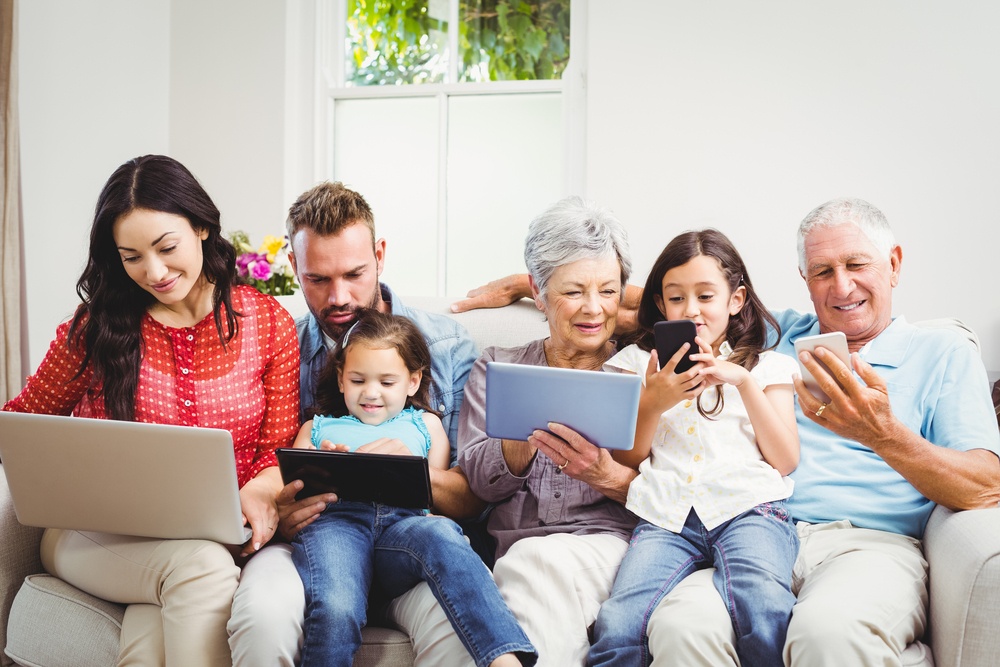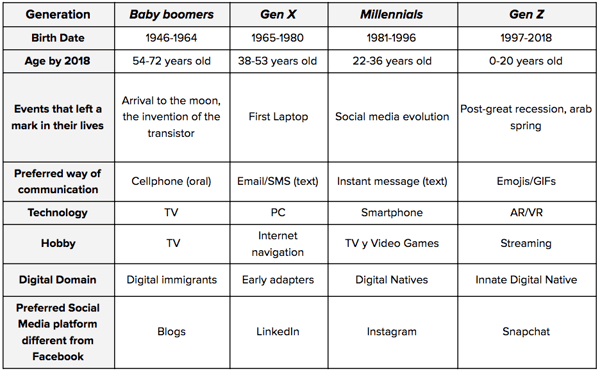
The success of a communication plan lies not only in an attractive message or in a great story behind the product or service. But, it is important to understand the following:
- Who is our audience and how does it relate to the environment and take advantage of it?
- Through which allies are we going to get this information and what is the most effective media when launching a communication campaign?
The idea seems common sense or a bit weird. However, the media revolution in which we live, the changes in behavior in new consumers and the cultural clash between baby boomers, generation X, millennials, and generation Z force us to build relevant and specific contact points for each audience.
Baby boomers and their particular way of understanding the world

The new older adults generation has radically changed the way of living the retirement: every day they are more dynamic, participatory, economically active and with a high level of loyalty to brands and products. Additionally, they do not stop breaking the stereotypes inherited by their predecessors: the greatest / silence Generation.
How do they consume content?
According to data from the University of Colorado, 87% of the baby boomer population (52 to 64 years old) uses Facebook as their main social network and 60% of them use blogs and digital articles as basic information media. In contrast, this generation spends about 3 hours per day on entertainment television.
That first percentage (87%) clearly shows us that Facebook is this generation favorite network, but this doesn't mean that the majority of its users are baby boomers. In fact, it has users of all generations, especially Gen Z, who sometimes run into their parents in it. What happens is that Facebook is the only network where baby boomers participate because people "understand them" more than others, such as Twitter or Snapchat.
The forgotten generation X

It seems that people born between 1965 and 1980 have a curse of identity that to date they have not been able to break. While older people feel an enormous empathy and similarity with the baby boomers, the younger ones identify with the way of living and thinking of the new generations, which leaves a gap when building communication focused on this part of the population.
How do they consume content?
To the surprise of many skeptics, Nielsen's latest report found that xers are more addicted to digital platforms than any other generation: spend, on average, 7 hours a week on social networks, an extra hour compared to their predecessors; not only that but also have the highest rate of television consumption.
Millennial overexploitation

About Millennials, people have said EVERYTHING: that they hate working, that they don't have a strong level of commitment, that they don't know how to relate outside social networks and that they are practically guilty of all the social ills. However, the truth is that by 2019 they will become the largest population group in the world, which will represent a huge source of consumption.
How do they consume content?
Last year, Nielsen released a study in which he estimates that traditional television is still the first media used by this generation to spend their free time (around 66%), while devices such as video game consoles, VCRs, and streaming is 23%. At the end of the list are computers with 8%, smartphones with 2% and, finally, tablets with 1%.
Something to highlight is that this group of people tend to get bored very quickly or get distracted very easily, which makes the experience very dynamic when consuming any content.
Generation Z: the Facebook growing fear

They have the impression that Facebook is their parents' digital platform, but this is not entirely true (as we explained above). The reality is that this is the social network where both generations run into and that's why Gen Z has that impression of Facebook.
If there is something that makes us feel old and with a certain sense of anxiety, it is the called Gen Z, which is a "little guys" generation born under the sacred mantle of digital: it seems that they know everything or they can investigate it just by searching it on their smartphones. They can't understand how the world was without computers or, worse, without internet, and see other generations as if they were running towards the future in slow motion.
How do they consume content?
According to a study conducted by Piper Jaffray, 47% of these teenagers consider Snapchat as their preferred social network, followed by Instagram with 24%, while Facebook barely reaches the third place with 9%. In the last year, the Mark Zuckerberg's platform had a 3.4% fall of popularity in users between 12 and 17 years, this is why it would not be surprising that when Kylie Jenner announced the closure of her Snapchat account, the blue giant was the first one to be happy with the new.
Learn the differences that mark each generation

We will show you a couple of data obtained from Generation At Glance that is useful to understand how each generation has its own characteristics:
Knowing the media and ways in which our target is informed is vital when building a communication strategy. Taking for granted that through a single channel we can reach all audiences is a mistake that can become expensive and inefficient.
All generations run into Facebook, so it is important to highlight that Mexico is the fifth country in the world with 76 M active users, Mexico City is the second, after Bangkok, with 19 M active users. Are you taking advantage of it?
Remember that to take advantage of these figures and to avoid any confusion of origin in your strategy, it is important to consult experts who know how the networks where you will send your message and know how to analyze the specific target, including their consumption and entertainment habits.

